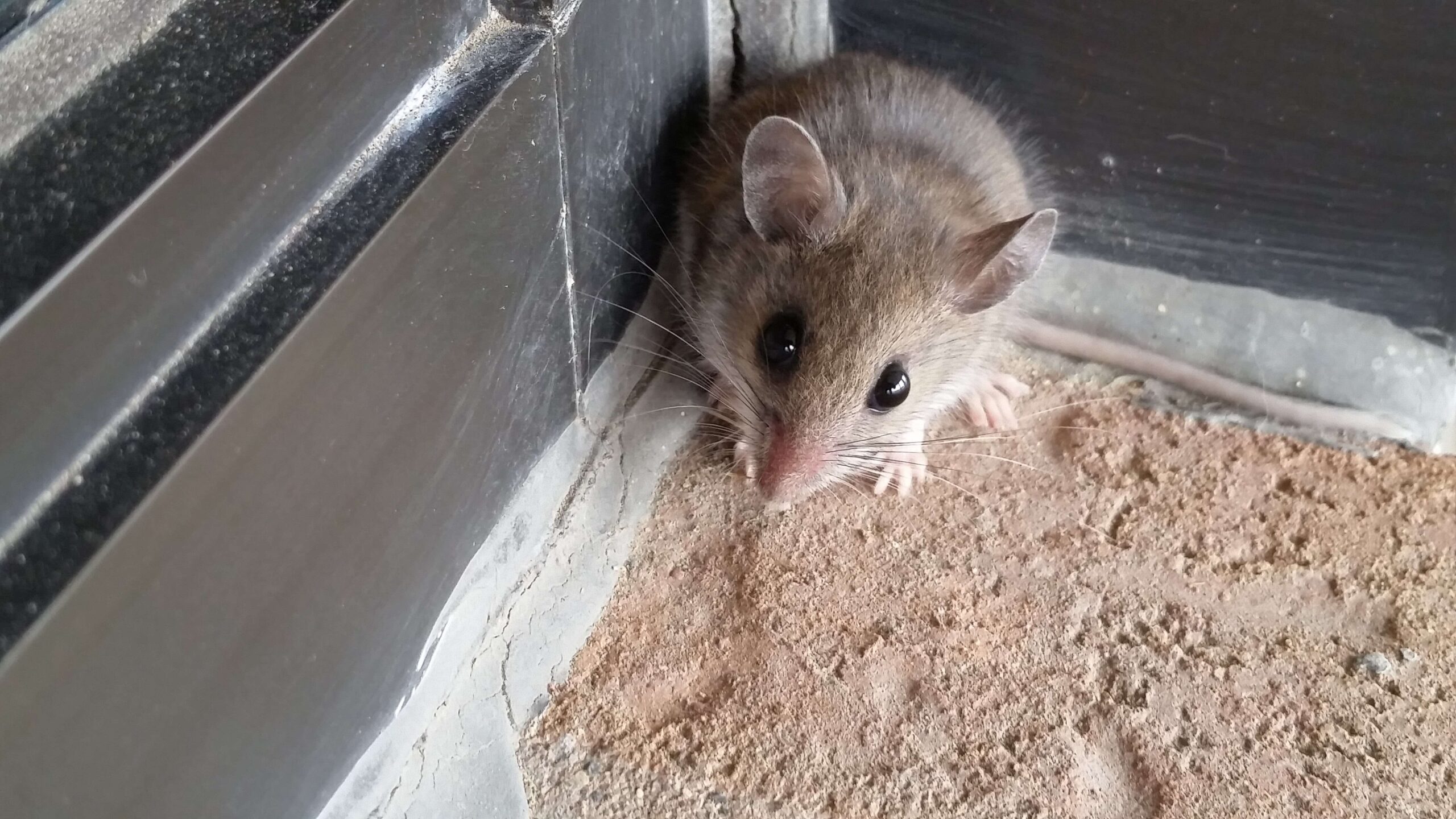MOUSE REMOVAL PROCESS
Assess and Remove
You can’t resolve a mouse problem if you don’t know how they’re getting in. We begin with a thorough 50 point inspection of your home’s exterior and interior to identify all mouse entry points. We then remove the mice using expertly installed one-way doors that allow the mice to leave for food but prevent them from getting back in.
Clear and Clean
Mice are messy, leaving droppings and urine behind wherever they go. Skedaddle offers cleaning and sanitizing services to safely remove harmful mouse droppings and contaminated building materials to return your home to a liveable state.
Prevent and Protect
The results from our initial home inspection will provide us with a full understanding of what areas of your home needs to be sealed against future mice infestations. Our wildlife technicians will use professional grade wildlife exclusion materials to prevent any possible re-entry and keep mice out.
Mice in Ottawa
Mice are one of the most common pests to make their way into and occupy Ottawa homes. Their small size makes it easy for them to squeeze into tiny cracks and gaps found on the outside of houses. Once inside their activity can cause pricey home damage and their droppings and urine can lead to health risks. At the very first sign of mouse activity your best course of action is to contact Skedaddle, Ottawa’s leader in mouse removal since 1989.
Where You will Find Mice in Ottawa
Skedaddle receives thousands of calls each year from frustrated Ottawa homeowners dealing with mouse problems. Mice are found in all parts of the city, from dense, older neighbourhoods near the core, like Centretown, the Glebe and Sandy Hill to newly built suburban communities in Barrhaven, Kanata and Orleans. Both century homes and those newly constructed present possibilities for mice to make entry. Mice need only a very small gap to get into a house. Some openings may form over time, as any house deteriorates, while others are left behind by builders and tradespeople who fail to consider mice during construction.
Mouse infestations often come with a stigma and some might take their presence as a sign of poor housekeeping. To be clear, clutter and unprotected food can serve to make mouse problems worse but even the most incredibly tidy home could find itself hosting mice. Once mice make their way in they generally shy away from coming into contact with the people living inside, preferring to nest the places most homeowners never go like the attic, wall voids, ceilings and behind cabinetry. These spaces provide them with shelter from Ottawa’s cold winters, a place to store food and protection from predators. Sure, they might be tempted by some crumbs that have fallen below the stove, but even without a food source your house’s hidden voids alone are still very attractive to mice.
Mouse Entry Points
Our homes are just not built to be mouse proof and all it takes is a single opportunistic rodent scurrying along your home’s foundation to find their entry point. Mice communicate through pheromones that they leave behind everywhere they go and help mark your home as a destination for other mice in the neighbourhood. This silent communication is the reason why so many mouse problems persist year after year even with the help of traps and poisons. So long as openings exist, mice will continue to make their way inside.
The long-term fix for any mouse infestation is to identify and seal their exterior entry points. Finding mouse entry points generally takes experience and a keen eye. Mice are capable of making their way into very small gaps and openings and because they can climb they are every bit as likely to be entering along the roof line as they are at ground level. Each home is going to present mice with different avenues for entry depending its size, how it was constructed and the condition of the building materials used.
Skedaddle begins each mouse removal with a comprehensive home and property assessment. Our trained technicians inspect your home’s exterior as well interior space mice like to occupy, like garages and attics, to get an understanding of how mice are entering and what will be required to remove them and prevent them from re-entering.
Even though each mouse removal is different, there are some hot spots found on most homes that Skedaddle technicians will be sure to investigate on almost every inspection. If you take a drive through the neighbourhoods and communities built around Ottawa over the past 30 to 40 years you will find similar design and construction themes that have been repeated by builders all over the city. In recent decades many homes in Ottawa have been built with a front brick veneer or while the sides and rear of the home are finished with vinyl siding.
These houses, very often with attached garages, often present similar avenues for mice entry. The vulnerabilities are often found where two different building materials meet but not quite tight enough to keep mice out. Weep holes between bricks, gaps where the brick meets the soffit or where the siding meets the foundation are all common mouse entry points found on Ottawa homes. Other avenues might include gaps around gas and air conditioning lines that enter the house or openings for vents. Mouse entry points are rarely obvious to an untrained eye and are often hidden from plain sight, below decks or behind shrubs and finding them means you have to be prepared to get dirty.
Mouse Proofing Your Ottawa Home
Once our technicians have identified every current mouse entry point and potential future points of concern we will take the time to discuss our findings and walk you through the removal and prevention plan. In most cases that means going along every inch by sealing each and every gap around your foundation, garage and roofline to prevent mouse entry in the future. To get rid of the mice currently occupying your home our team will install one-way doors over their entry points that allow mice to exit to gather food but prevent them re-entering. Skedaddle’s team of mouse removal specialists have been helping Ottawa home owners rid themselves of mice for over 30 years. Call us today to schedule an inspection and take the first steps to protect your home and family from mice.
Mouse Facts
Mice are about as keen on running into a human as you are to run into them. Getting bit by a wild mouse is quite unlikely unless you attempt to catch it with your hands. Good luck with that, though. They can run up to eight miles per hour, which is the equivalent of 160 miles per hour for the average human!
FACT:
Mice do not carry rabies, but that doesn’t mean that they don’t pose a risk to human health. They can transmit a number of other diseases including salmonellosis, leptospirosis and lymphocytic Chorio-meningitis, all of which are transmitted via their feces and urine.
FACT:
Mice are prolific breeders, a female can give birth to anywhere between five and 12 pups in a single litter, and she may have up to 10 litters in a year.
FACT:
The teeth in a rodent never stop growing. Gnawing on hard surfaces is one way to keep them sharp and filed down. Mice inside homes have been known to chew on wood, electrical wiring and even soft plumbing and dishwasher lines.
FACT:
Mice are small and shy, and they are nocturnal. This makes it difficult to detect their presence. Most homeowners with mice will rarely see the mice themselves. Instead they are usually alerted to a problem by hearing mouse activity in the walls or the attic at night or discovering droppings, often in cupboards below sinks or basement furnace rooms.
FACT:
The most common variety of mouse found in Ottawa homes are white-footed mouse and the house mouse. In rural areas, or homes close to woodland deer mice will also make their way into houses.
CHECK OUT OUR LATEST BLOGS
Help! How Do I Remove These Rodents From My Home?
Spring Mouse Activity: Preparing Your Home for Increased Rodent Movement
Mouse Nesting Habits: Why Your Walls Are Their Dream Home
How To Stop Mice From Getting Into Your Food In Your Kitchen
How Mice Could Cause A Fire Hazard In Your Home






